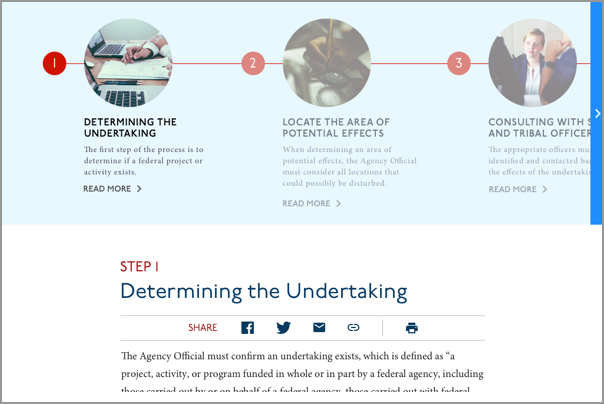Overview
The Advisory Council on Historic Preservation strives to ensure federal agencies implement their work in harmony with the National Historic Preservation Act. Section 106 requires federal agencies to consider the effects of projects they carry out, approve, or fund on historic properties. The ACHP has published regulations that guide federal agencies and other participants in the Section 106 process.

Working with Section 106
Browse the Digital Library for a wide range of Section 106 resources, publications, and guidance. The following provide in-depth information about current issues of interest to Section 106 users.
Section 106 Regulations: 36 CFR Part 800
Citizen's Guide to Section 106 Review
Guía del ciudadano sobre la revisión de proyectos conforme a la Sección 106
Section 106 and Infrastructure Projects
Integrating NEPA and Section 106
Guidance on Agreement Documents
Section 106 Program Alternatives
Nationwide Programmatic Agreements
Section 106 Case Book (1966-2000)
Section 106 Applicant Toolkit
Section 106 Archaeology Guidance
Resources for SHPOs
Partners and Participants
The ACHP works with partners in the Section 106 process including State Historic Preservation Officers and Tribal Historic Preservation Officers. As well, Federal Preservation Officers are important components of the process. The ACHP maintains partnerships with certain federal agencies to provide dedicated support to their Section 106 program improvements
Federal Agency Program Partnerships
Contacting the ACHP About Section 106
For technical assistance about Section 106 or to reach the ACHP staff about consultations where the ACHP is participating, please contact the Office of Federal Agency Programs at ofap_help@achp.gov.
Electronic Submissions and Notices to the ACHP
Please submit notices of adverse effect through our Electronic Section 106 Documentation Submittal System (e106). The system allows for receipt acknowledgment and quicker turnaround times since materials are not delayed by mailing or manual processing. Attachments such as a cover letter, reports, maps, and responses or summaries of consulting party comments can and should be included. Please refrain from mailing duplicate hard copies of any materials sent via electronic mail to the e106 system or ACHP staff. Agencies are also encouraged to communicate electronically with other Section 106 stakeholders, including State and Tribal Historic Preservation Officers, and Indian tribes and Native Hawaiian organizations (NHOs), and other consulting parties consistent with their capacity and stated willingness to do so.


